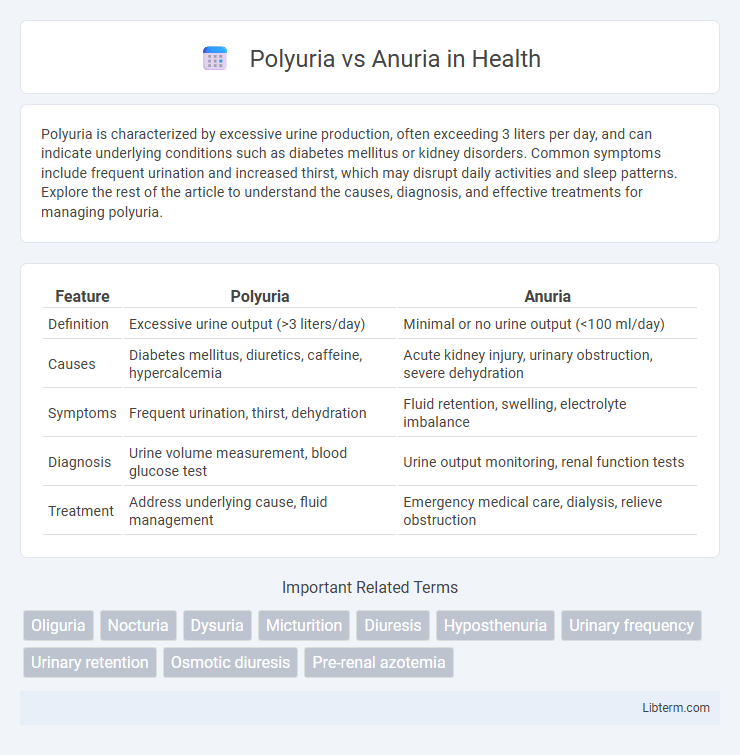Polyuria is characterized by excessive urine production, often exceeding 3 liters per day, and can indicate underlying conditions such as diabetes mellitus or kidney disorders. Common symptoms include frequent urination and increased thirst, which may disrupt daily activities and sleep patterns. Explore the rest of the article to understand the causes, diagnosis, and effective treatments for managing polyuria.
Table of Comparison
| Feature | Polyuria | Anuria |
|---|---|---|
| Definition | Excessive urine output (>3 liters/day) | Minimal or no urine output (<100 ml/day) |
| Causes | Diabetes mellitus, diuretics, caffeine, hypercalcemia | Acute kidney injury, urinary obstruction, severe dehydration |
| Symptoms | Frequent urination, thirst, dehydration | Fluid retention, swelling, electrolyte imbalance |
| Diagnosis | Urine volume measurement, blood glucose test | Urine output monitoring, renal function tests |
| Treatment | Address underlying cause, fluid management | Emergency medical care, dialysis, relieve obstruction |
Introduction to Polyuria and Anuria
Polyuria is characterized by excessive urine production exceeding 3 liters per day, often linked to conditions such as diabetes mellitus or diuretic use. Anuria refers to the complete absence of urine output, typically less than 100 milliliters per day, signaling severe renal dysfunction or urinary tract obstruction. Differentiating between polyuria and anuria is crucial for diagnosing underlying pathologies and guiding appropriate clinical management.
Definitions: What is Polyuria? What is Anuria?
Polyuria is defined as the excessive production of urine, typically exceeding 3 liters per day, often caused by conditions such as diabetes mellitus or excessive fluid intake. Anuria refers to the complete absence or passage of less than 100 milliliters of urine per day, usually indicating severe kidney failure or urinary obstruction. Understanding these distinct urinary output abnormalities is crucial for diagnosing and managing underlying renal or systemic diseases.
Key Differences Between Polyuria and Anuria
Polyuria is characterized by the excessive production of urine exceeding 3 liters per day, often caused by conditions like diabetes mellitus or diuretics use, whereas anuria refers to the complete absence or less than 100 milliliters of urine output daily, typically resulting from severe kidney failure or urinary tract obstruction. Polyuria leads to dehydration and electrolyte imbalances due to excessive fluid loss, while anuria indicates renal dysfunction requiring immediate medical intervention to prevent life-threatening complications. Understanding these distinct urine output volumes and underlying causes is crucial for differential diagnosis and appropriate treatment strategies.
Common Causes of Polyuria
Polyuria, characterized by excessive urine output exceeding 3 liters per day in adults, commonly results from conditions such as uncontrolled diabetes mellitus, which causes osmotic diuresis due to high blood glucose levels. Other frequent causes include diabetes insipidus, where antidiuretic hormone (ADH) deficiency or resistance leads to impaired water reabsorption, and chronic kidney disease affecting the kidney's concentrating ability. In contrast, anuria signifies a severe reduction in urine output below 100 mL per day, often caused by acute kidney injury, obstruction of urinary tract, or severe dehydration.
Common Causes of Anuria
Anuria is characterized by the complete absence of urine output, commonly caused by acute kidney injury, severe dehydration, urinary tract obstruction, or advanced renal failure. In contrast, polyuria involves excessive urine production, often due to diabetes mellitus, diabetes insipidus, or excessive fluid intake. Understanding the underlying causes of anuria is critical for timely diagnosis and treatment to prevent irreversible kidney damage.
Symptoms and Clinical Manifestations
Polyuria is characterized by excessive urine output exceeding 2.5 liters per day, often causing symptoms like frequent urination, dehydration, and nocturia. Anuria, defined by urine output less than 100 milliliters per day, presents clinically with symptoms such as oliguria, fluid retention, swelling, and electrolyte imbalances. Both conditions indicate underlying renal or systemic pathology requiring prompt diagnostic evaluation for appropriate management.
Diagnostic Approaches for Polyuria vs Anuria
Diagnostic approaches for polyuria involve assessing urine output exceeding 3 liters per day through 24-hour urine collection and measuring serum electrolytes to identify causes like diabetes insipidus or uncontrolled diabetes mellitus. In contrast, anuria diagnosis requires urgent evaluation of urine output less than 100 milliliters per day combined with renal function tests, imaging studies such as renal ultrasound to detect obstruction, and assessing for acute kidney injury or chronic kidney disease. Differentiating between polyuria and anuria emphasizes urine volume measurement, biochemical tests, and relevant imaging modalities for precise identification of underlying renal pathology.
Potential Complications and Health Risks
Polyuria, characterized by excessive urine output often exceeding 3 liters per day, can lead to dehydration, electrolyte imbalances, and kidney damage if untreated, increasing the risk of acute kidney injury. Anuria, defined as urine output less than 100 milliliters per day, signals severe kidney dysfunction or obstruction, posing critical risks including fluid overload, metabolic acidosis, and life-threatening uremia. Both conditions necessitate prompt medical evaluation due to their potential to precipitate serious complications like chronic kidney disease and cardiovascular instability.
Treatment and Management Strategies
Polyuria treatment focuses on addressing underlying causes such as diabetes mellitus, requiring strict glycemic control and use of medications like desmopressin for diabetes insipidus, while ensuring adequate hydration to prevent dehydration. Anuria management involves urgent identification and treatment of obstructive causes, kidney failure, or severe dehydration, often necessitating interventions like dialysis or catheterization to restore urine output. Both conditions require careful monitoring of electrolyte balance and fluid status to prevent complications and optimize patient outcomes.
Prevention and Lifestyle Recommendations
Managing fluid intake and maintaining a balanced diet rich in electrolytes help prevent polyuria and anuria by supporting kidney function and hydration levels. Regular monitoring of blood sugar levels and blood pressure reduces risks associated with diabetes and hypertension, common causes of abnormal urine output. Avoiding excessive caffeine, alcohol, and certain medications like diuretics decreases the likelihood of disrupting normal urine production.
Polyuria Infographic

 libterm.com
libterm.com